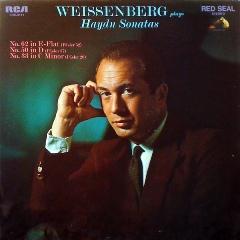Haydn – Sonatas No. 62 No. 50 No. 33 (1969)
Haydn – Sonatas No. 62 No. 50 No. 33 (1969)

Piano Sonata No. 62 In E-flat Major (Päsler 52) 1 I. Allegro Moderato 7:32 2 II. Adagio 6:53 3 III. Finale (Presto) 4:48 Piano Sonata No. 33 In C Minor (Päsler 20) 4 I. Moderato 5:26 5 II. Andante Con Moto 4:00 6 III. Finale (Allegro) 3:50 Piano Sonata No. 50 In D Major (Päsler 37) 7 I. Allegro Con Brio 3:31 8 II. Largo E Sostenuto – 9 III. Finale (Presto, Ma Non Troppo) 4:42 Alexis Weissenberg – piano
Haydn's famous London Sonatas can be viewed as the distillation of the composer's entire sonata-writing experience. Often described as a symphony for the piano, Sonata No. 62 has frequently been praised as Haydn's ‘opus summum' due to its large-scale form, diversity of expression and its virtuoso requirements. --- linnrecords.com
Haydn wrote Sonata No.50 for the Auenbrugger sisters, who were Viennese patrons he met while serving as Kapellmeister in the Court of Prince Esterhazy. Often composers would have to take into account the technical limitations of the performers for whom they were writing, but Haydn felt few constraints in this case because the Auenbrugger sisters were, according to him, accomplished keyboard players to rank with the finest in Europe. He thus produced this Sonata in D major, which is quite challenging for even talented performers today.
The first movement, marked Allegro con brio, opens with a playful, humorous theme that brims with energy, especially in the second subject and subsidiary material. The mood is bright and carefree until the development section is reached, about midway through. Here, the music turns a bit toward the serious side, but in the reprise the lighter, brighter mood from the opening returns.
In the ensuing movement (Largo e sostenuto), things become utterly serious, the main theme having a solemnity to its almost funereal character, the music's elegance and stately manner at times seeming to verge on eruption. Just when the listener senses the bleakness will worsen or even turn violent, the Presto finale begins, Haydn avoiding the usual pause. The mood is bright, once again, and even more playful than in the first movement. The chipper main theme alternates first with more muscular, rather clownish music, then with a variant exhibiting much the same kind of effervescence and spirited demeanor. While the writing in this movement is challenging, it is also colorful and quite substantive for the listener. This charming Sonata, usually listed as No. 50 in Haydn's catalog, is short, typically lasting about 10 or 11 minutes. --- Robert Cummings, Rovi
Although the autograph bears the date 1771, Haydn withheld publication of the famous C minor Sonata, No 20, until 1780, when it appeared as the last, and by far the most challenging, of the set dedicated to the Auenbrugger sisters. With its abrupt dynamic contrasts, this is the first of Haydn’s keyboard works conceived essentially in terms of a touch-sensitive instrument—either the clavichord or the new fortepiano—rather than the harpsichord. Its expansive scale and virtuoso demands are unprecedented in Haydn’s sonatas before the 1790s, while its tragic intensity is matched in his keyboard music only by the F minor Variations of 1793. This is Haydn’s ‘Appassionata’. The first movement—whose elegiac main theme in parallel thirds and sixths Brahms perhaps subconsciously recalled in his song of a dying girl, Immer leiser wird mein Schlummer—combines soulful Empfindsamkeit, Sturm und Drang turbulence and argumentative rigour. Haydn enhances the music’s poignancy with passages of ‘speaking’ recitative, like heartfelt oratory.
The Andante con moto, in A flat major, unfolding over an expressive running bass line, is another Haydn slow movement with a distinct Baroque flavour. But with its textural complexity and wide harmonic reach it inhabits a different world from the earlier sonatas. Constant syncopations give the music a restless, yearning edge, rising to passion in the mounting sequences that sweep the music into the recapitulation. The finale, written against the background of a fast minuet, has a latent despairing fury that becomes manifest towards the end. Mingling violence and virtuosity, Haydn here expands a brief toccata-like sequence in an astounding crossed-hands passage, with the left hand touching the extremes of the contemporary five-octave keyboard. ---Richard Wigmore, hyperion-records.co.uk
download (mp3 @320 kbs):
uploaded yandex 4shared mega mediafire zalivalka cloudmailru oboom uplea








